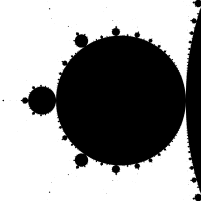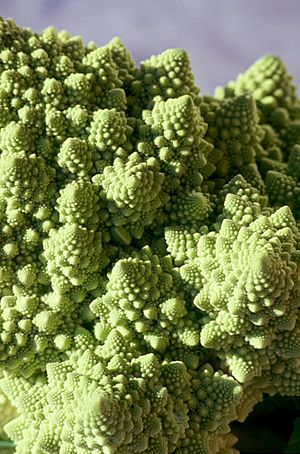Self-similarity facts for kids

Something is self-similar if it looks very much like a part of itself. Imagine you have a big picture, and a tiny piece of that picture looks exactly like the whole big picture. That's self-similarity!
For example, the Mandelbrot set is a famous mathematical shape. If you zoom into any part of it, you will find smaller, almost exact copies of the whole shape. It's like an endless pattern within itself.
Contents
What is Self-Similarity?
Self-similarity means an object or shape is made up of smaller copies of itself. These smaller copies might be exactly the same or just very similar. It's a cool idea found in both math and nature.
Self-Similarity in Nature
You can see self-similarity all around you. Think about a fern leaf. Each small frond (leaf part) looks like a tiny version of the whole fern.
- Trees: A branch of a tree often looks like a smaller tree itself.
- Coastlines: If you look at a coastline from far away, it has a certain jagged shape. If you zoom in on a small section, it still has that same kind of jaggedness.
- Snowflakes: Each arm of a snowflake can have smaller, similar patterns repeating.
- Romanesco Broccoli: This vegetable is a perfect example. Its bumps are arranged in a spiral, and each small bump is a miniature version of the whole head.
Self-Similarity in Math
In mathematics, self-similarity is a key idea in the study of fractals. Fractals are special shapes that show self-similarity at different scales. This means no matter how much you zoom in, the pattern keeps repeating.
- Mandelbrot Set: This is a famous fractal. It has an infinite number of tiny, similar shapes hidden within it.
- Koch Curve: This is a line that gets more and more detailed as you zoom in. Each small part of the curve looks like the whole curve.
- Sierpinski Triangle: This shape is made by repeatedly removing smaller triangles from a larger one. The remaining parts are smaller copies of the original triangle.
Why is Self-Similarity Important?
Scientists and mathematicians study self-similarity for many reasons. It helps us understand:
- Natural patterns: How complex shapes in nature, like clouds or mountains, are formed.
- Computer graphics: How to create realistic landscapes and textures in video games and movies.
- Data compression: How to store information more efficiently by finding repeating patterns.
- Chaos theory: How small changes can lead to big, complex outcomes, often with self-similar patterns.
It's a fascinating concept that shows how simple rules can create incredibly detailed and beautiful structures.
Images for kids
See also
 In Spanish: Autosimilitud para niños
In Spanish: Autosimilitud para niños






